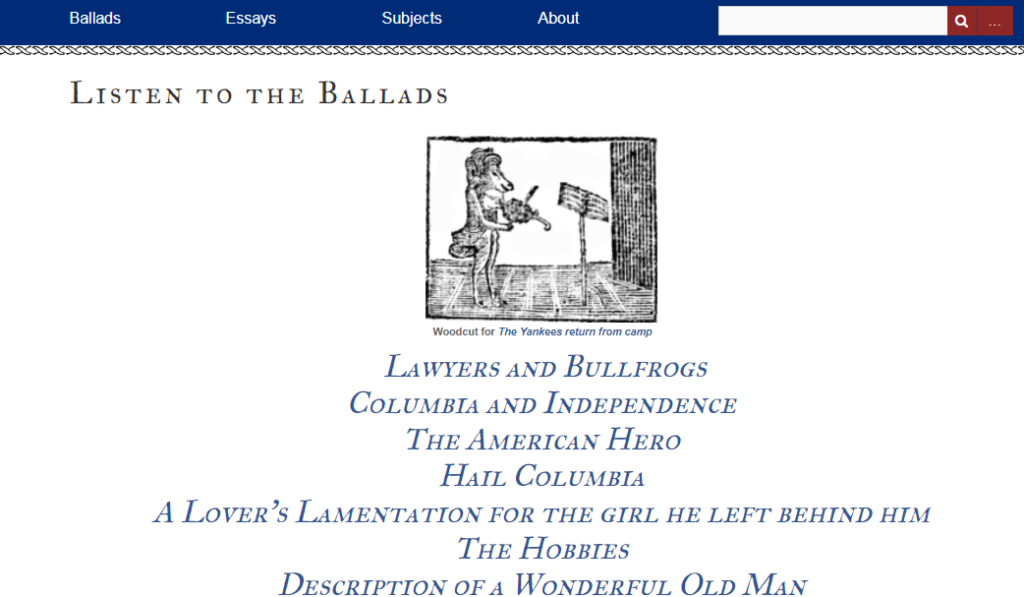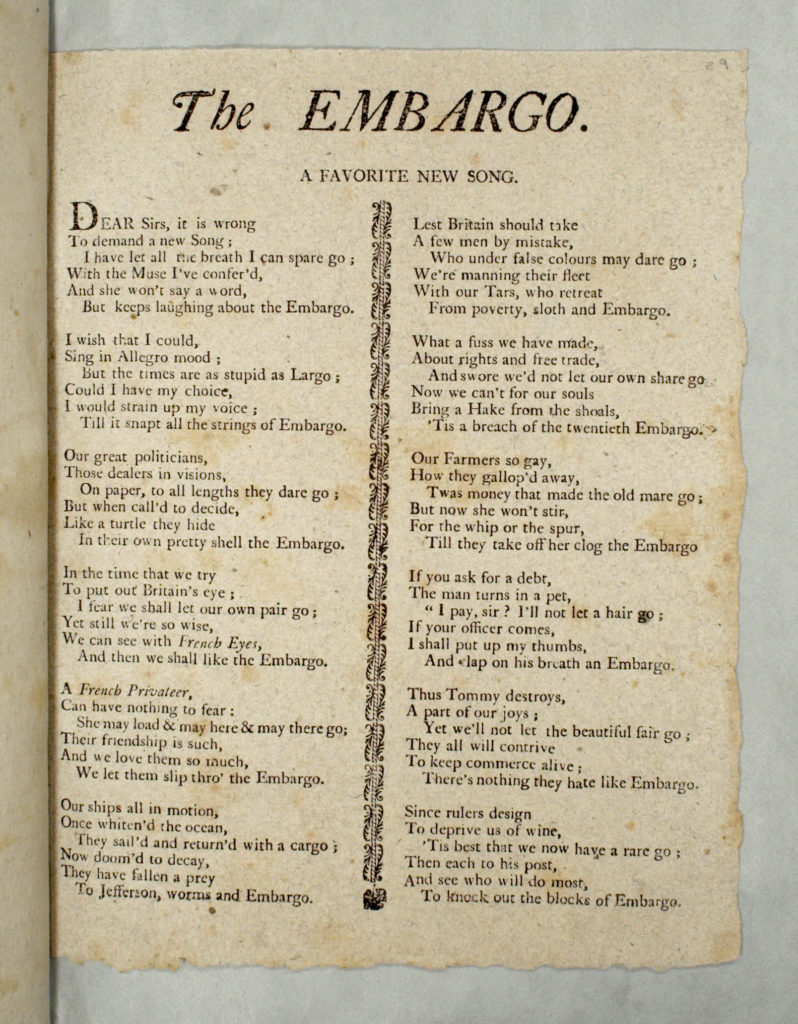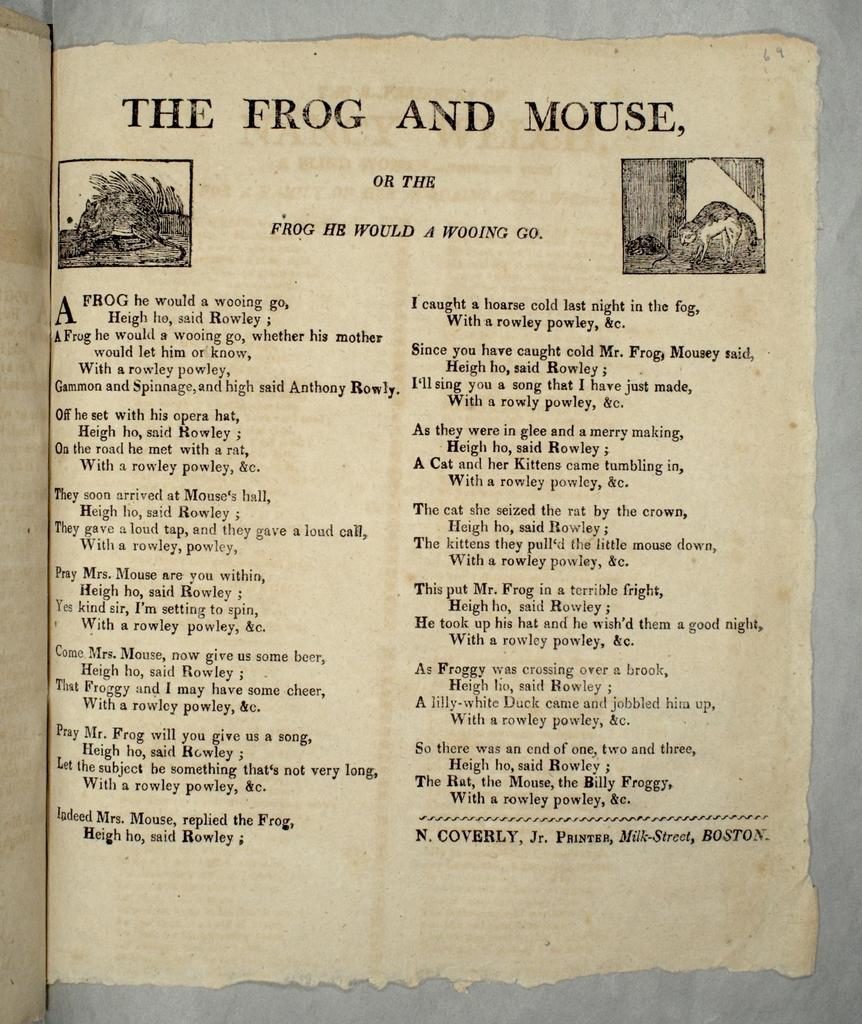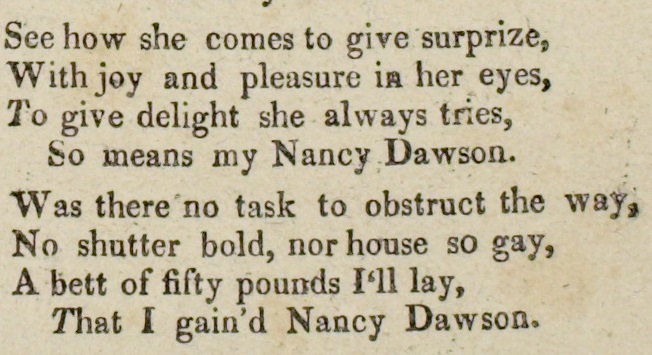David Hildebrand, Ph.D., specializes in researching, recording, and performing early American music. He presents concerts and educational programs throughout the country for museums, universities, and historical organizations, and has consulted for and provided soundtrack materials for numerous documentaries, such as the PBS series Liberty!—the American Revolution, Rediscovering George Washington, and Anthem. He also teaches at the Peabody Conservatory and has worked closely with AAS to record broadside ballads as part of the Isaiah Thomas Broadside Ballads Project.
 Single-sheet broadsides printed over two hundred years ago are quiet things. The 298 sheets amassed by Isaiah Thomas in 1814 were designed to communicate stories and opinions, and many of them were no doubt read quietly by individuals while others were read aloud, proclaiming that text in public. This post concerns those clearly intended to be sung, 37 of which are now recorded and available for listening through the Isaiah Thomas Broadside Ballads Project.
Single-sheet broadsides printed over two hundred years ago are quiet things. The 298 sheets amassed by Isaiah Thomas in 1814 were designed to communicate stories and opinions, and many of them were no doubt read quietly by individuals while others were read aloud, proclaiming that text in public. This post concerns those clearly intended to be sung, 37 of which are now recorded and available for listening through the Isaiah Thomas Broadside Ballads Project.
How does one accurately interpret the style of singing these ballads? Better, is there one “historically accurate” manner in which they were sung in their day? I believe the answer to be no, there was no clearly defined group of people who purchased and sang these; rather those early nineteenth-century American singers were diverse. Some were wealthy and could afford musical training, but most probably didn’t. And regardless of training, people’s ability to carry a tune well, at pitch and with proper rhythm, probably varied more according to their natural musical talent and practice than whether they had taken lessons or not. The same is surely true today as well!
 Hopefully, whoever sang about Thomas Jefferson’s ill-advised trade embargo (The Embargo. A Favorite New Song ) would allow the biting satire and harsh accusations within the lyrics to come out with force and heartfelt anger. President Jefferson ironically thought an embargo would convince the British in 1806 to respect our right to free trade, but it was an economic disaster, hated by nearly all. And these same citizens, greatly relieved at the embargo’s repeal, celebrated mirthfully by singing Thomas’s The Death of the Embargo to the tune of “Yankee Doodle.”
Hopefully, whoever sang about Thomas Jefferson’s ill-advised trade embargo (The Embargo. A Favorite New Song ) would allow the biting satire and harsh accusations within the lyrics to come out with force and heartfelt anger. President Jefferson ironically thought an embargo would convince the British in 1806 to respect our right to free trade, but it was an economic disaster, hated by nearly all. And these same citizens, greatly relieved at the embargo’s repeal, celebrated mirthfully by singing Thomas’s The Death of the Embargo to the tune of “Yankee Doodle.”
As a singer with practically no formal vocal training yet decades of practical experience interpreting songs of all sorts, I put myself in the mindset of those vociferating their convictions, for or against the topic at hand. When singing a narrative ballad, like The Death of General Wolfe, I become a storyteller, pretending to be the first to deliver, to eager ears, the dramatic account of the Battle of Quebec. This means throwing extra energy into such lines as “when shot from off his horse,” where clearly the accent falls on the word SHOT with its abrupt finial consonant. Similarly, in Massachusetts Song of Liberty such lines as these require vituperative delivery:
The italics and exclamations in the text emphasize the word Tyrants! These are clearly guidelines for the singer to follow: spit such words out, sneeringly!
Other questions I had to ask in bringing music to life from a centuries-old page: in which key do I sing it? I chose to pick the one that best suits my vocal range. How fast or slow should it be? Slow enough to enunciate and communicate the text, yet fast enough to catch and keep a listener’s interest. Should I use vibrato? I don’t think much should be used; a mild, natural vibrato works, but certainly not a big, wobbly operatic one.
 For comic songs, and there are plenty, I chose to include a chuckle in my voice on the punch-lines—why not? Lawyers and Bullfrogs is simply silly; the listener has even more fun hearing it sung with gusto and some lines delivered deadpan for extra emphasis. The Frog and Mouse, or the Frog He Would a Wooing Go involves such a jaunty nonsense chorus it’s hard not to have fun singing it. Francis Hopkinson’s famed Battle of the Kegs reminds me of the writings of Dr. Seuss; the words are so clever, imaginative, and well-crafted rhythmically.
For comic songs, and there are plenty, I chose to include a chuckle in my voice on the punch-lines—why not? Lawyers and Bullfrogs is simply silly; the listener has even more fun hearing it sung with gusto and some lines delivered deadpan for extra emphasis. The Frog and Mouse, or the Frog He Would a Wooing Go involves such a jaunty nonsense chorus it’s hard not to have fun singing it. Francis Hopkinson’s famed Battle of the Kegs reminds me of the writings of Dr. Seuss; the words are so clever, imaginative, and well-crafted rhythmically.
At the other end of the spectrum are the serious and moving “Indian Speeches,” in which the horrific impact of alcohol upon Native Americans is denounced, along with the belligerent and cruel behavior of white Americans towards them. Five of these are recorded, including Indian Letter and Indian Speech, Delivered before a Gentleman. These all stand out from the others as being spoken rather than sung. My brother Mark Hildebrand declaims these with a dark foreboding.
Try a few yourself—there is a huge variety of topics. You’ll discover, as I did, that the chief obstacle to making them work smoothly is determining which syllables within each line fall on the musical accents of the indicated tune. Making a printout and adding underlines helps, such as the following verse and chorus of Nancy Dawson, seen here as marked for recording next to a detail of the original broadside:
 See how she comes to give surprise,
See how she comes to give surprise,
With joy and pleasure in her eyes:
To give delight she always tries,
So means my Nancy Dawson.
Was there no task, to obstruct the way,
No shutter bold, nor house so gay,
A bett of fifty pounds I’ll lay,
That I gain’d Nancy Dawson.
In some cases, when no tune is indicated, try to find one that works in terms of number of lines and syllables per line. So listen, learn, re-create, and celebrate this amazing slice of U.S. history. You may just find yourself humming on the way out the door.
